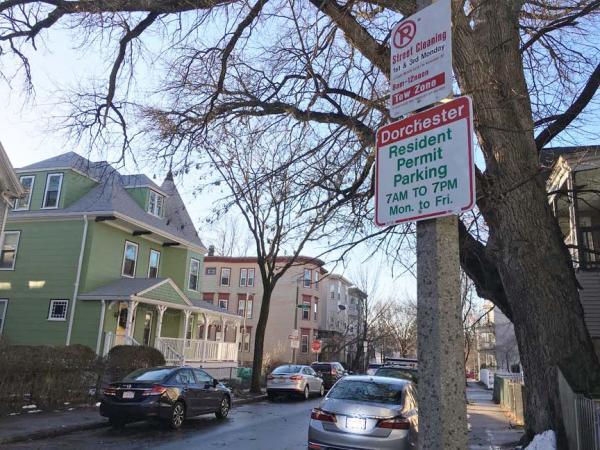January 12, 2017

Discussions about residential parking are churning inside Dorchester’s neighborhoods that increasingly are pressed for space. With resident-only parking permits decided piecemeal, stashing a car can be a trial for renters and homeowners alike, not to leave out securing a space for visiting family and friends looking to park nearby for a summer potluck.
Three streets in the Hancock Street Civic Association area of Uphams Corner are working out details to become resident-restricted to some extent. At a meeting of the association on Jan. 3, president Marti Glynn said traffic and parking along Bird and Glendale streets is now “a 24-hour problem. It’s not just during the day; it’s not just at night; it’s all the time.”
Bird and Glendale streets and Whittemore Terrace have enough signatories to move forward to become resident parking streets. The process is relatively straightforward – 51 percent of adult residents on at least two neighborhood streets sign a petition, describing the traffic and parking problems and details of the requested resident parking.
Upon receiving the petition, the neighborhood coordinator at the Office of Neighborhood Services works with Transportation Department officials to convene community meetings. If approved, parking changes generally take at least three months to set up.
Fifteen Dorchester streets became resident-restricted in 2016, according to Boston Transportation Department spokeswoman Tracey Ganiatsos. They join a citywide collection of roads with different densities, lengths, and specific time limitations.
Boston offers every resident permit parking on approved streets for the cars that they own. Unlike in Cambridge, Bostonians get their permits for free, with no limit to the number of cars per household. A spot is not guaranteed; the permit is for the right to park in an open resident space within the approved neighborhood, like Dorchester or South Boston or Roxbury. Visitors and those using rental cars are out of luck in most cases.
“It’s nice for people to know that you can go to somewhere else in Dorchester and park legally,” said Vicki Rugo with the Ashmont Hill Neighborhood Association, although she also notes, “You don’t have to live on a street with resident parking to get a resident sticker, which kind of contradicts the intent of the program, I think.”
A disadvantage, Rugo said, is the overall inconsistency. Signage can change abruptly halfway along a street, as on Ocean Street, leaving the demarcation between open and resident-only parking fuzzy.
Dorchester has a much lower concentration of parking permits than the rest of the city, particularly car-swamped South Boston and the North End. As of this week, Ganiatsos said, there are 5,875 active Dorchester resident parking permits. Across the city, the number pushes 100,000.
The permits are somewhat disconnected from the proliferation of resident parking, which has to be navigated on instinct, memory, or often pure chance. “It becomes common knowledge once you live here that Ashmont Street is resident parking except for these two spaces on the corner,” Rugo said.
There is no central list of resident-only parking streets, or a map of Boston neighborhoods marking them. Some villages produce makeshift hyper-local maps, as the Greater Ashmont Main Streets organization did.
Searching for the original record of when some Ashmont Hill streets were designated resident-only, Rugo found an article in a back-issue of the association newsletter from 1999 listing segments of Alban, Ashmont, Ocean, and Burt streets that were made resident parking in July 1999. Five more joined that number in the Ashmont/Peabody Square area this year: Adanac Terrace, Barna Road, and Carruth, Euclid, and Fairfax streets.
The city is working to better catalogue its parking situation, Ganiatsos said, adding that Boston’s Parking Atlas and Rules Census (BPARC) is a long-term project in its early stages.
The census is meant to “build a comprehensive, accurate, easily updatable database of parking regulations on City of Boston streets,” Ganiatsos said in an email. “The purpose of the project is to collect data to be used as a decision making tool in managing existing programs and designing new parking plans.”
While the city maps streets, different ends of Dorchester are feeling the parking pinch differently, civic leaders say.
Fields Corner, which has a distinct commercial spine that has expanded with a number of new restaurants and trendy cafes, has few resident-only streets. The small, one-way Montello Street became resident-only parking in 2016.
Debbie and Steve Sousa, who are members of the Fields Corner Civic Association, say they are wary of the pressures posed by much-touted Transit-Oriented Developments. Projects falling within a certain distance of a transit stop can be classified as “transit-oriented,” allowing developers to move forward with fewer parking spaces included in their plans, the assumption being that residents would be hopping on the T.
“It’s unrealistic to think that people won’t have a car,” Steve Sousa said. He said he anticipates parking becoming increasingly more of a premium commodity as more developments pop up. The types of businesses the civic group is seeing, such as restaurants, are those that depend on accessible parking locations.
As in other villages with easily accessible MBTA stops, “we see a lot of people coming in from outside Fields Corner, parking by the library, on side streets, and walking to the Red Line,” Sousa said. Still, the civic group has not spearheaded a recent effort to expand resident parking in the commercial center.
“The long and short of it,” said Debbie Sousa, “is it’s never been an issue that has come before Fields Corner Civic Association in the past year. It could be a potential discussion topic, absolutely. In Fields Corner itself, there’s that catch-22 between where’s the balance between residents being able to use the parking, and how do we support our businesses coming in that desperately need parking spaces to support their business?”
Topics:


